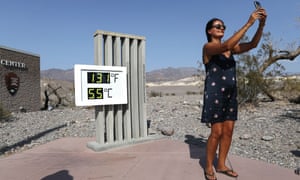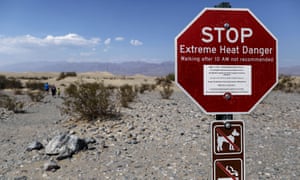Death Valley’s forbidding landscape registered a preliminary high temperature of 129.9F on 16 August. Don’t look away
How hot was it at the Furnace Creek visitor center at Death Valley national park on 16 August 2020? It was so hot that the huge electronic temperature display (which serves as a ubiquitous selfie backdrop) went on the fritz. Parts of the blocky digital display malfunctioned, resulting in numbers even higher than the actual mind-melting high on what turned out to be a landmark day.
An automated weather station at the visitor center recorded a preliminary high of 129.9F (54.4C) at 3.41pm PDT on Sunday. Even for heat-favored landscapes such as Death Valley, it is remarkable for temperatures to inch into such territory so late in the summer, when the sun is considerably lower in the sky than at the summer solstice in late June. According to weather records researcher Maximiliano Herrera, the previous global record high for August is 127.9F (53.3C), recorded in Mitribah, Kuwait, in 2011.
If Sunday’s high at Death Valley is confirmed, it will be the planet’s highest temperature in almost a century and its third-highest on record, according to the World Meteorological Organization (WMO). Owing to the fact that the two higher readings are in question, it may, in fact, be the hottest air temperature ever recorded on Earth.
The 130F afternoon in Death Valley fits snugly in the “what next?” narrative of life in 2020. But because human-caused climate change is such a ubiquitous yet gradual process, it’s rarely at the top of the news. A surging societal issue will typically bump climate from the headlines. There’s been no lack of such US events in 2020, from the coronavirus pandemic to police brutality and the state of the US Postal Service ahead of the November elections.
Climate science, and common sense, warn that it would be unwise, however, to skip over what has just happened in the California desert.
While competing events jostle for our attention, the machinery driving the climate crisis lumbers onward. Even in a year when global carbon emissions are on track to dip by a few percent, thanks largely to reduced travel and shuttered workplaces, the total amount of carbon dioxide concentrated in the atmosphere will once again reach its highest value in millions of years, about half a percent more than in 2019.

The effects are perceptible. The Arctic experienced its first 100F day on record on 17 June when the Siberian town of Verkhoyansk hit 100.4F (38C). July 2020 was the hottest single month in more than a century of recordkeeping at such far-flung US locations as Phoenix; Miami; and Portland, Maine.
How can we be sure that the 130F reading really is the record-setter it appears to be? Even higher temperatures often make the rounds in newspapers or social media. However, these are typically drawn from thermometers exposed to the sun, which leads to readings higher than the actual air temperature, as was the case with the 145F (63C) reported from Kuwait in 2019. Official temperatures are collected from shaded instrument shelters, designed and outfitted under strict protocols established by the WMO (part of the United Nations).
The WMO, which also serves as the global arbiter of major weather records, plans to investigate the Death Valley report. Such post-mortems typically involve double-checking the temperature sensor’s performance, evaluating the station and its landscape, and assessing nearby observations to make sure they support the case.
The only readings hotter than Sunday’s that are recognized by WMO are 134F (56.7C) at Death Valley on 10 July 1913, and 131F (55C) at Death Valley on 13 July 1913, and at Kebili, Tunisia, in July 1931.
Questions swirl around those early 20th century values, though. For decades, the world’s all-time record high was believed to be the 136.4F (58C) reported from Al Azizia, Libya, on 13 September 1922. Weather historian Christopher Burt was skeptical: the value didn’t comport with nearby stations, and the thermometer design made it easy to misread the temperature.
Burt’s work with colleagues led to an overturning of the Al Azizia record by WMO in 2012, a saga documented in the Weather Underground film Dead Heat. Burt and Herrera have called out similar issues with the Death Valley and Kebili readings from the 1910s and 1930s. Thus far the WMO has not re-evaluated those.
Parsing the planet’s highest temperature by degrees, or tenths of degrees, may seem like a pedantic task in the face of a global climate crisis with vast consequences. Yet without careful, consistent measurement, it will be all the more difficult to keep track of a changing climate as it careens through our lives.
Death Valley is already a forbidding landscape, one where heat and dryness rule and few people spend more than a day or two. A warming planet is unlikely to yield more Death Valleys in our lifetimes. However, it is pushing saline water into the delicate freshwater landscape of the Everglades, attacking the namesake ice of Glacier national park, and triggering an onslaught of changes both subtle and profound to ecosystems across the continent.
With all this in mind, perhaps we should linger over a 130-degree afternoon a little longer.
.png)

No comments:
Post a Comment